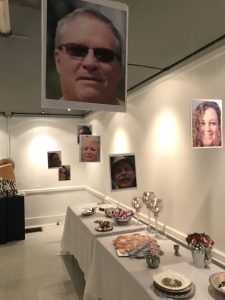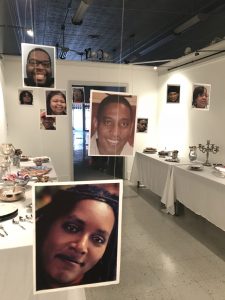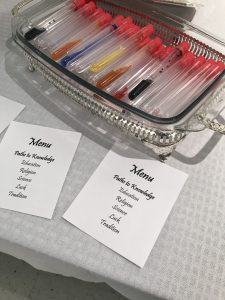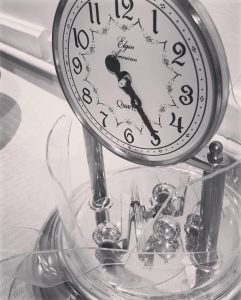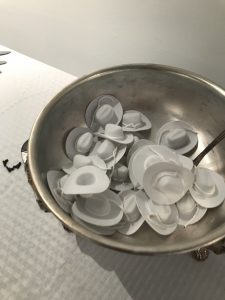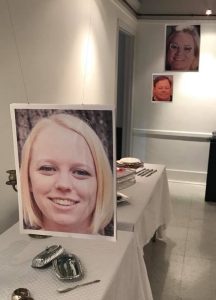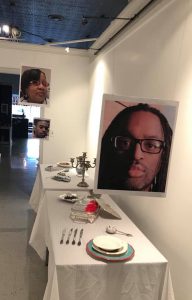The symbols of culture and controversy from last year’s “At the Table I: Red and Blue” exhibit were set on serving tables and placed in a small, intimate setting.
In “At the Table II: White and Black”, viewers were given faces to consider. From the west entry to this small, pass-thru gallery, all of the faces belong to white people. From the east entry, all of the faces are of black people.
“At the Table II” invites viewers to consider the factors that shape our identities and opinions. A spoonful of religion, a dab of science, a dash of luck – items we encounter in our quest for knowledge.
Fears are presented as well; a shattered clock represents death, the stopping of time.
Justice is depicted via white cowboy hats that used to represent our faith in ourselves as heroes, “the good guys”. It’s a role that has slipped away as we recognized the “indians” we decimated were Native American tribes with a rich history of their own.
At the second level, “At the Table II” gives viewers an opportunity to be present among engaging faces, both black and white, who are here at the table. Viewers were invited to ask themselves what it feels like to share space with people of another race. How are our opinions shaped by the racial makeup of the people around us?
An awareness of shared company lets viewers consider the banquet of symbols through someone else’s eyes.
“At the Table II: White and Black” is an opportunity to consider the different contexts that we bring to our conversations about important issues.
Notes:
There is a man whose face is posted twice – on the window sign for the exhibit, and inside the piece. On the window sign, this black man is smiling at the camera, and he is wearing a business suit. In the exhibit, he is not. Some black men say is that they feel pressured to put on a smiling face in order to avoid arousing fear in white Americans.
Gratitude – I want to express my deep gratitude to my wonderful friends for being the art in the art show: Anne, Antowan, Elizabeth, Emily, Eric, Gail, Gene, Ian, Janet, Jemima, Jolivette, Karl, Kathy, Kia, Leitha, Mandy, Marcus, Mark, Patti, Rick, Ron, Susan, Susie, and Warren.
Special thanks to the Athens of Indiana Art Gallery, Diana McCormick, Kathy Steele, Helen Hudson, Nina Cunningham, and to Ian Bailey for his Facebook group “Conversations With White People: Talking About Race” where I have learned so much.
Thank you to Mom and Steph for your feedback and support.
And thanks to Jenny for asking me to paint faces.
My inspiration for this installation is an event that happened in 2002.
I signed up to do quick-sketch portraits at “Arts & Crafts” fairs at a dozen shopping malls throughout the Chicagoland area. I’d bring my art supplies and chairs and easel, and spend the weekend drawing people.
One Saturday morning, as I was setting up my equipment, I realized that the shopping mall where I’d be working was a black mall. Everyone around me was black. Everyone.
My first instinct was to grab my stuff and leave. I didn’t belong, this wasn’t my space, I was doing the wrong thing. It might not be safe.
But then I looked around at everyone. They were just minding their business, doing their thing. How racist of me to assume that a black mall would not be safe. There was nothing to fear. I thought about that – and about the $150 I’d paid to be there. And how much I wanted to draw. I decided to stay.
And of course, I had a wonderful time drawing people. One teenager’s portrait turned out especially good – he was full of attitude and easy to draw. He was delighted: “Ooooh, that’s gangsta!” he said. “Now, is that good?” I laughed. It was a great day.
In between customers, I did a lot of people-watching that challenged more of my racism. Old and young, rich and poor, professional and working-class, quiet and flashy, conventional and unconventional. So much variety; much more variety and complexity than I expected. I didn’t realize how limited my expectation was, how much it was defined by stereotypes and ignorance.

